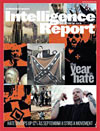Editor Mark Potok explores the last year of activity on the radical right and a street battle in York, Pa. that caught the nation’s attention.
War came to York, Pa., the other day, and although York seemed to survive the battle relatively unscathed, the radical right may never be quite the same.
Just as the attacks of Sept. 11 left behind a nation newly awakened to the bloody reality of terror directed from abroad, the far less dramatic events in York — where hundreds of white supremacists battled anarchists and other “anti-racists” in the streets — also had important implications for the future.
The battle of Jan. 12 may have been the first on our shores of the kind of massive street brawls that have been familiar to most Europeans for more than a decade now.
The scene was right out of the former East Germany, perhaps, or any of the hundreds of other European venues where “antifas” (anti-fascists) and neo-Nazis have battled it out with clubs, knives and Molotov cocktails.
No one was killed in York, but after a day of running street battles between white supremacists and masked anarchists, some 25 people had been arrested, all but two of them anti-racists, and the racially troubled city of 40,000 was left in shock.
Not so the supremacists. Finally, after decades of trying to take their battle into the streets, they had managed to focus the attention of millions of Americans on their willingness to fight “to save the white race.”
As usual, it was the violence of their enemies — members of Anti-Racist Action and a Boston anarchist group called the Barricada Collective — that put the racists on the front page.
“We’ve done the work of heroes, ladies and gentlemen,” exulted Billy Roper, deputy membership coordinator of the National Alliance, America’s top neo-Nazi group, after the battle of York.
“Let’s all take a deep breath and then begin focusing on how we can do even better.”
The Movement Expands
Roper was right. It was a good day for the National Alliance, not to mention other violently racist groups like the World Church of the Creator, the Eastern Hammerskins, the Aryan Nations and the National Socialist Movement.
It displayed the growing willingness of right-wing extremists to work together across party lines. It cast light on the increasingly Nazified aspects of the most energetic portion of the American radical right.
And it reflected the growing size and confidence of a movement that was once consigned to the shadows of American life.
That growth is also captured in the latest annual count of hate groups by the Southern Poverty Law Center’s Intelligence Project.
The number of hate groups operating in the United States last year reached 676, the second 12% rise in as many years, and it was accompanied by a similar increase in hate websites.
At the same time, there were signs of a developing alliance between American and European neo-Nazi groups and their Islamic extremist counterparts.
This expansion of the radical right is part of a major historical development over the last decade. Not since the early decades of the 20th century has the extreme right done so well across so much of the Western hemisphere.
The spread of multicultural ideology, the diminishing percentage of whites in the world, major waves of immigration into the United States and Europe, and the long march of globalization have all contributed to the historic crossroads where we now find ourselves:
Multicultural integration versus the kind of racist ethnic nationalism that destroyed Yugoslavia.
From Europe, With Hate
As the American movement has grown, it has taken much from its European counterpart:
-
Holocaust denial began in Europe.
-
Racist Skinheads came to the United States in the early 1980s from Britain and other parts of the continent.
-
A decade later, the racist white power music that had become popular in Europe — “hatecore” — arrived on our shores.
-
Racist versions of pagan religions like Scandinavian Odinism spread like wildfire in the United States of the ’90s.
-
More recently, U.S. radicals have adopted new interpretations of fascism popularized by European thinkers.
Now, European-style public confrontation — street battles, public marches by formerly secretive groups, in-your-face racist activism — is here.
That is good news for American white supremacists, who live off the attention that they get in the press and who increasingly sense things going their way.
For them, the more battles and the more violence — especially of the sort sparked by so-called anti-racists who insist that Nazis have no free speech rights — the better.
And it is bad news for York and the rest of us.
“We have forever stripped away the lie of the controlled mass media that we are a ‘fringe’ group or that we lack public support,” said a delighted Matt Hale, chief of the neo-Nazi World Church of the Creator and convener of the Pennsylvania rally.
“I will be coming back to York very, very soon.”



